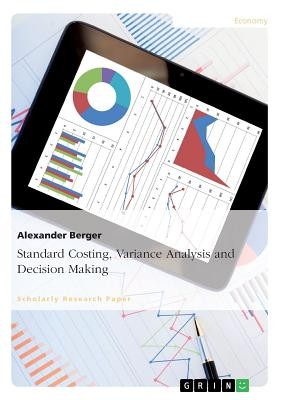
- We will send in 10–14 business days.
- Author: Alexander Berger
- Publisher: GRIN Verlag
- Year: 2011
- Pages: 40
- ISBN-10: 3640955986
- ISBN-13: 9783640955985
- Format: 14.8 x 21 x 0.3 cm, minkšti viršeliai
- Language: English
- SAVE -10% with code: EXTRA
Standard Costing, Variance Analysis and Decision-Making (e-book) (used book) | bookbook.eu
Reviews
Description
Research Paper (undergraduate) from the year 2011 in the subject Business economics - Accounting and Taxes, grade: 63%, University of Sunderland, course: Management Accounting and Control, language: English, abstract: This report is divided into two parts. The first part will explain how a standard costing system works and how a variance analysis is used properly. Furthermore, the statement "Standard Costing and Variance Analysis are appropriate to any type and size of organisation" will be critically evaluated. The second part determines factors, which must be considered in the decision-making process. In addition, four scenarios of decisions will be provided and analysed. One of the main objectives of an organisation is to minimise the cost of production and to control the costs as they are limited resources within a business (Gupta, 2010). Management accounting literature provides several tools in order to achieve these objectives. In this context, the system for collecting and reporting revenue and cost information by areas of responsibility is called responsibility accounting (Siegel & Shim, 2006). It is based on the assumption that managers should be held responsible for their performance. A well-designed responsibility accounting system integrates responsibility centers within the organisation. In addition, responsibility centers are units within the organization, which have control over costs and revenues (Siegel & Shim, 2006). There are different types of responsibility centers such as profit centers, investment centers, revenue centers and cost centers. In the following report, the focus is on cost centers. Here, a variance analysis based on standard costing is a performance measure of a cost center (Siegel & Shim, 2006). In addition, a standard costing system is a useful tool facilitating decision-making.
EXTRA 10 % discount with code: EXTRA
The promotion ends in 23d.18:57:31
The discount code is valid when purchasing from 10 €. Discounts do not stack.
- Author: Alexander Berger
- Publisher: GRIN Verlag
- Year: 2011
- Pages: 40
- ISBN-10: 3640955986
- ISBN-13: 9783640955985
- Format: 14.8 x 21 x 0.3 cm, minkšti viršeliai
- Language: English English
Research Paper (undergraduate) from the year 2011 in the subject Business economics - Accounting and Taxes, grade: 63%, University of Sunderland, course: Management Accounting and Control, language: English, abstract: This report is divided into two parts. The first part will explain how a standard costing system works and how a variance analysis is used properly. Furthermore, the statement "Standard Costing and Variance Analysis are appropriate to any type and size of organisation" will be critically evaluated. The second part determines factors, which must be considered in the decision-making process. In addition, four scenarios of decisions will be provided and analysed. One of the main objectives of an organisation is to minimise the cost of production and to control the costs as they are limited resources within a business (Gupta, 2010). Management accounting literature provides several tools in order to achieve these objectives. In this context, the system for collecting and reporting revenue and cost information by areas of responsibility is called responsibility accounting (Siegel & Shim, 2006). It is based on the assumption that managers should be held responsible for their performance. A well-designed responsibility accounting system integrates responsibility centers within the organisation. In addition, responsibility centers are units within the organization, which have control over costs and revenues (Siegel & Shim, 2006). There are different types of responsibility centers such as profit centers, investment centers, revenue centers and cost centers. In the following report, the focus is on cost centers. Here, a variance analysis based on standard costing is a performance measure of a cost center (Siegel & Shim, 2006). In addition, a standard costing system is a useful tool facilitating decision-making.


Reviews